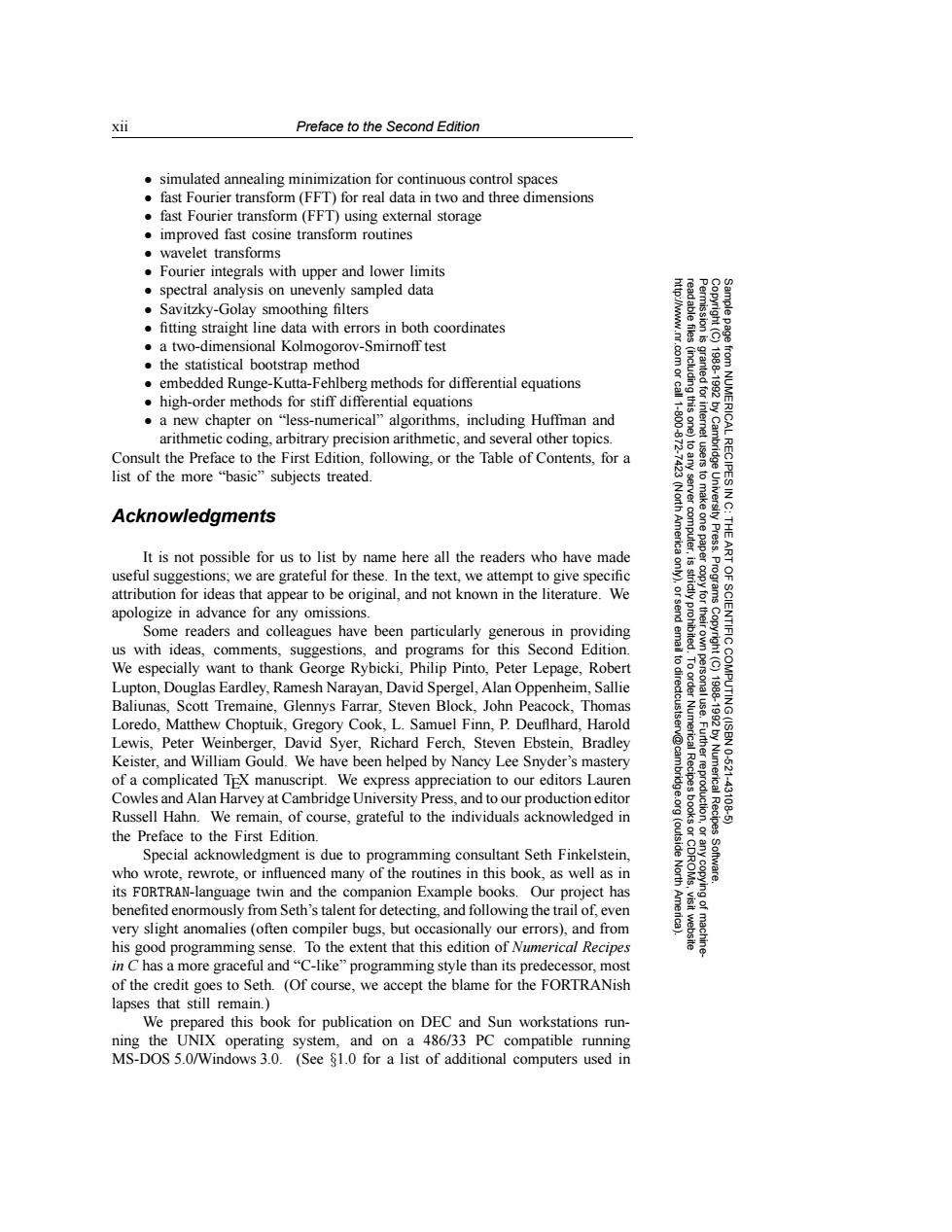正在加载图片...

xii Preface to the Second Edition simulated annealing minimization for continuous control spaces fast Fourier transform(FFT)for real data in two and three dimensions fast Fourier transform (FFT)using external storage improved fast cosine transform routines wavelet transforms Fourier integrals with upper and lower limits spectral analysis on unevenly sampled data .Savitzky-Golay smoothing filters fitting straight line data with errors in both coordinates a two-dimensional Kolmogorov-Smirnoff test the statistical bootstrap method 8 embedded Runge-Kutta-Fehlberg methods for differential equations 虽 nted for high-order methods for stiff differential equations a new chapter on "less-numerical"algorithms,including Huffman and arithmetic coding,arbitrary precision arithmetic,and several other topics. Consult the Preface to the First Edition,following,or the Table of Contents,for a list of the more "basic"subjects treated. Acknowledgments It is not possible for us to list by name here all the readers who have made useful suggestions;we are grateful for these.In the text,we attempt to give specific attribution for ideas that appear to be original,and not known in the literature.We apologize in advance for any omissions. 三笪∽的 Some readers and colleagues have been particularly generous in providing OF SCIENTIFIC us with ideas,comments,suggestions,and programs for this Second Edition. We especially want to thank George Rybicki,Philip Pinto,Peter Lepage,Robert 6 Lupton,Douglas Eardley,Ramesh Narayan,David Spergel,Alan Oppenheim,Sallie Baliunas,Scott Tremaine,Glennys Farrar,Steven Block,John Peacock,Thomas Loredo,Matthew Choptuik,Gregory Cook,L.Samuel Finn,P.Deuflhard,Harold Lewis,Peter Weinberger,David Syer,Richard Ferch,Steven Ebstein,Bradley Keister,and William Gould.We have been helped by Nancy Lee Snyder's mastery 70入。公 Recipes Numerica 10621 of a complicated TEX manuscript.We express appreciation to our editors Lauren Cowles and Alan Harvey at Cambridge University Press,and to our production editor Russell Hahn.We remain,of course,grateful to the individuals acknowledged in the Preface to the First Edition. Special acknowledgment is due to programming consultant Seth Finkelstein, who wrote.rewrote,or influenced many of the routines in this book,as well as in its FORTRAN-language twin and the companion Example books.Our project has benefited enormously from Seth's talent for detecting,and following the trail of,even very slight anomalies (often compiler bugs,but occasionally our errors),and from his good programming sense.To the extent that this edition of Numerical Recipes in C has a more graceful and "C-like"programming style than its predecessor,most of the credit goes to Seth.(Of course,we accept the blame for the FORTRANish lapses that still remain.) We prepared this book for publication on DEC and Sun workstations run- ning the UNIX operating system,and on a 486/33 PC compatible running MS-DOS 5.0/Windows 3.0.(See $1.0 for a list of additional computers used inxii Preface to the Second Edition Permission is granted for internet users to make one paper copy for their own personal use. Further reproduction, or any copyin Copyright (C) 1988-1992 by Cambridge University Press. Programs Copyright (C) 1988-1992 by Numerical Recipes Software. Sample page from NUMERICAL RECIPES IN C: THE ART OF SCIENTIFIC COMPUTING (ISBN 0-521-43108-5) g of machinereadable files (including this one) to any server computer, is strictly prohibited. To order Numerical Recipes books or CDROMs, visit website http://www.nr.com or call 1-800-872-7423 (North America only), or send email to directcustserv@cambridge.org (outside North America). • simulated annealing minimization for continuous control spaces • fast Fourier transform (FFT) for real data in two and three dimensions • fast Fourier transform (FFT) using external storage • improved fast cosine transform routines • wavelet transforms • Fourier integrals with upper and lower limits • spectral analysis on unevenly sampled data • Savitzky-Golay smoothing filters • fitting straight line data with errors in both coordinates • a two-dimensional Kolmogorov-Smirnoff test • the statistical bootstrap method • embedded Runge-Kutta-Fehlberg methods for differential equations • high-order methods for stiff differential equations • a new chapter on “less-numerical” algorithms, including Huffman and arithmetic coding, arbitrary precision arithmetic, and several other topics. Consult the Preface to the First Edition, following, or the Table of Contents, for a list of the more “basic” subjects treated. Acknowledgments It is not possible for us to list by name here all the readers who have made useful suggestions; we are grateful for these. In the text, we attempt to give specific attribution for ideas that appear to be original, and not known in the literature. We apologize in advance for any omissions. Some readers and colleagues have been particularly generous in providing us with ideas, comments, suggestions, and programs for this Second Edition. We especially want to thank George Rybicki, Philip Pinto, Peter Lepage, Robert Lupton, Douglas Eardley, Ramesh Narayan, David Spergel, Alan Oppenheim, Sallie Baliunas, Scott Tremaine, Glennys Farrar, Steven Block, John Peacock, Thomas Loredo, Matthew Choptuik, Gregory Cook, L. Samuel Finn, P. Deuflhard, Harold Lewis, Peter Weinberger, David Syer, Richard Ferch, Steven Ebstein, Bradley Keister, and William Gould. We have been helped by Nancy Lee Snyder’s mastery of a complicated TEX manuscript. We express appreciation to our editors Lauren Cowles and Alan Harvey at Cambridge University Press, and to our production editor Russell Hahn. We remain, of course, grateful to the individuals acknowledged in the Preface to the First Edition. Special acknowledgment is due to programming consultant Seth Finkelstein, who wrote, rewrote, or influenced many of the routines in this book, as well as in its FORTRAN-language twin and the companion Example books. Our project has benefited enormously from Seth’s talent for detecting, and following the trail of, even very slight anomalies (often compiler bugs, but occasionally our errors), and from his good programming sense. To the extent that this edition of Numerical Recipes in C has a more graceful and “C-like” programming style than its predecessor, most of the credit goes to Seth. (Of course, we accept the blame for the FORTRANish lapses that still remain.) We prepared this book for publication on DEC and Sun workstations running the UNIX operating system, and on a 486/33 PC compatible running MS-DOS 5.0/Windows 3.0. (See §1.0 for a list of additional computers used in